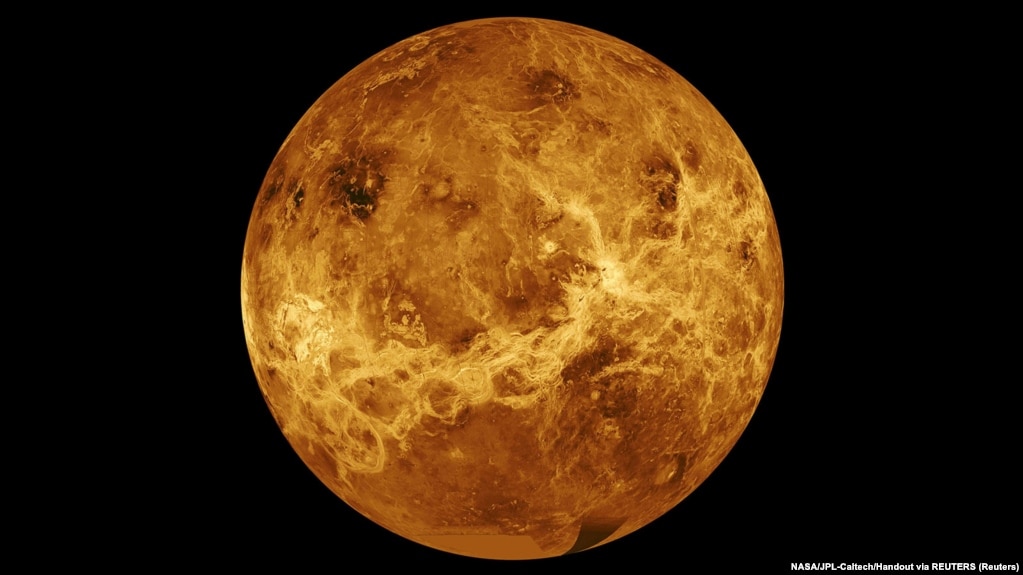私にとって、 宇宙は 神秘そのもの!!
でも科学者はそ神秘を解明しようとする。
夜空を見上げて、叫んでみる!!
君は何処ー?
といっても、エイリアンにではありません。
私の心にです。自分を見つめるとき、夜空をただひたすら見つめていますね。危ない人かも???
きょうのVOAニュース、金星の生命体の可能性について。
Here we go!!
- 科学者たちが金星の生命体の可能性に疑問を呈する
- 地球外生命体の可能性ー53惑星?
- 地球外生命体の可能性ー3惑星
- 生命が存在できそうな一番近い系外惑星:地球からわずか11光年のところにある惑星ロス128b
- 地球という惑星を知ろうー生命発生の条件は?
- Scientists Wonder About Possible Sign of Life on Venus
科学者たちが金星の生命体の可能性に疑問を呈する
Scientists Wonder About Possible Sign of Life on Venus
宇宙科学者は、金星の大気中の生命の可能性の兆候である可能性があるものを発見しました。
この発見は、ネイチャー・アストロノミー誌に月曜日に発表された研究から出ています。
天文学者は、ハワイのジェームズクラークマクスウェル望遠鏡で金星を研究しました。彼らはチリのALMA電波望遠鏡で観測を確認しました。
望遠鏡は、惑星を覆う厚い雲のケミカルホスフィンの証拠を発見したのです。ホスフィンは有毒ガスです。地球上では、それは唯一、生命に関連付けられています。しかし、研究の主催者と他の専門家は、ホスフィンの存在が別の惑星に生命の証拠ではないことに同意しています。
※ホスフィン :分子式 PH 3 で表される、リンと水素による無機化合物。
この研究の報告書作成に協力したのは、デビッド・クレメンツ氏です。彼はインペリアル・カレッジ・ロンドンの研究者です。クレメンツ氏は、この証拠について「それは決定的な証拠ではありません。」と述べています。しかし、”何かを示唆している”かもしれないと付け加えています。
天文学者が太陽系外の生命の兆候を探すなかで、一つの方法は、生物学的プロセスからのみ生じる化学物質を探すことです。これらのプロセスはバイオシグネチャーとして知られています。
3人の天文学者がハワイのバーで出会った後、彼らは地球に少し近い金星のバイオシグネチャーを探すことにしました。3人は、3つの水素原子と1つのリン原子からなる分子、ホスフィンを探しました。
ホスフィンは、地球上では2つの方法でしか生成できません。工業的なプロセスで生成されるか、動物やよくわかっていない微生物の生物学的なプロセスで生成されるかです。一部の科学者はそれを廃棄物と考えています。
クレメンツ氏によると、ホスフィンは池の底やアナグマのような動物の体内、ペンギンの排泄物に含まれているといいます。
この研究にも関わった、マサチューセッツ工科大学の惑星科学者であるサラ・シーガー氏は、ホスフィンが含まれているかどうかを慎重に調べたといいます。:火山、落雷、大気中に落下する隕石など。「私たちが調べたプロセスの中で、私たちのチームの発見を説明するのに十分な量のホスフィンを生成できるものは一つもありませんでした」と彼女は言います。
生命が原因なのか?
天文学者たちは、水がなく、表面温度が摂氏425度の金星のような惑星に生命がどのように存在するかについて議論しました。
「金星は地獄です。金星は地球の邪悪な双子です。」とクレメンス氏は言います。
しかし、シーガー氏は、金星の地表から50キロ上空にある金星の厚い二酸化炭素雲の中では、室温程度であることを指摘しています。雲の大部分は硫酸でできています。しかし、それらはまた、非常に少量の水滴を含んでいます。
科学者たちは、ホスフィンが硫酸の滴の中に住んでいる微生物から来ているのではないかと考えました。シーガ氏ーとクレメンツ氏は、滴が地面に落ちると乾燥してしまうかもしれないが、他の滴に集まって生き返る可能性があるのではないかと指摘しています。
生命体が存在する可能性はあるが、他の数人の科学者は、より多くの証拠が必要だと言います。
コーネル大学の天文学者リサ・カルテネガー氏は、ガスが生物学的プロセスの兆候である可能性があるという考えは刺激的であると述べています。しかし、彼女は、生命が唯一の説明であるとは確信していません。
ヒューストンの月惑星研究所のジャスティン・フィルベルト氏は、ホスフィンのレベルは火山によって説明できるかもしれないとAP通信に語ってくれました。彼は、新しい研究では考慮されなかった最近の研究が、金星には科学者が考えていたよりもはるかに多くの活火山があるかもしれないことを示唆していると述べています。しかし、クレメンス氏は、金星が地球の少なくとも200倍以上の活動をしている場合にのみ、その説明は意味をなすだろうと述べています。
デビッド・グリンスプーン氏は惑星科学研究所の宇宙生物学者です。彼は金星に生命が存在する可能性を示唆する本を書いています。彼は興奮していますが、新しい研究の発見については”慎重”です。それは「あまりにも良すぎると思われそうです。」と彼は言います。
クレメンツ氏は、彼の頭の中では「おそらく10%の確率で生命が存在します。」と言っていると指摘しています。しかし、彼の心は「...もっと大きくなって欲しいと思っています。」と付け加えています。
地球外生命体の可能性ー53惑星?
地球外生命体の可能性ー3惑星
生命が存在できそうな一番近い系外惑星:地球からわずか11光年のところにある惑星ロス128b
地球という惑星を知ろうー生命発生の条件は?
1000万種以上もの生命が生きる星、地球。
生命が発生するための2条件
☆エネルギー源が存在すること
☆液体の水の存在
太陽光や地熱などのエネルギー源が存在すること、
そして、もう一つは、なによりなくてはならないもの、液体の水の存在です。地球上の生物の体がほとんど水でできていることからも、水は生命に必要不可欠であることがわかります。液体の水は、いろいろな化学反応の起こる場としてとても重要なのです。液体の水が惑星上に存在するためには、惑星の大きさと太陽からの距離が適当で、重力や地表温度が液体の水の存在を可能にする程度でなければなりません。とくに、液体の水が存在できる領域を、ハビタル・ゾーン(生命生存領域)と呼び、星から惑星までの距離で表されます。
惑星で生まれた生命が、さらに進化して行くためには、穏やかな気候、大気や磁場の存在が必要となってくるでしょう。
Scientists Wonder About Possible Sign of Life on Venus
 Data from NASA's Magellan spacecraft and Pioneer Venus Orbiter is used in an undated composite image of the planet Venus.
Data from NASA's Magellan spacecraft and Pioneer Venus Orbiter is used in an undated composite image of the planet Venus.
Space scientists have found what could be a possible sign of life in the atmosphere of Venus.
The finding comes from a study published Monday in Nature Astronomy.
The astronomers studied Venus with the James Clerk Maxwell Telescope in Hawaii. They confirmed their observations with the ALMA radio telescope in Chile.
The telescopes found evidence of the chemical phosphine in the thick clouds covering the planet. Phosphine is a poisonous gas. On Earth, it is only associated with life. However, the organizers of the study and other experts agree that the presence of phosphine is not proof of life on another planet.
David Clements helped to prepare a report on the study. He is with Imperial College London. Clements said of the evidence, “It’s not a smoking gun.” But he added that it may “be suggesting something.”
As astronomers look for signs of life outside our solar system, one method is to look for chemicals that result only from biological processes. These processes are known as biosignatures.
After three astronomers met in a bar in Hawaii, they decided to look for biosignatures a little closer to Earth – the planet Venus. The three looked for phosphine, a molecule made up of three hydrogen atoms and a single phosphorous atom.
Phosphine can form only two ways on Earth. It can be created by an industrial process, or it can come from a biological process in animals and microbes that is not well understood. Some scientists consider it a waste product.
Clements said phosphine can be found in the bottom of ponds, the insides of animals like badgers and in the waste of penguins.
Sara Seager, also involved in the study, is a planetary scientist with the Massachusetts Institute of Technology. She said the astronomers carefully looked at all the possibilities for production of the phosphine: volcanoes, lightning strikes or meteorites falling into the atmosphere. “…Not a single process we looked at could produce phosphine in high enough quantities to explain our team’s findings,” she said.
Could life be responsible?
The astronomers debated how life could exist on a planet like Venus, where there is no water and the surface temperature is 425 degrees Celsius.
“Venus is hell. Venus is Earth’s evil twin,” said Clements.
But Seager noted that 50 kilometers above the planet’s surface, in Venus’ thick carbon dioxide clouds, it is about room temperature. The clouds are mostly made up of sulfuric acid. But they also contain droplets with very small amounts of water.
The scientists asked themselves if the phosphine could be coming from microbes living inside the sulfuric acid droplets. Seager and Clements suggested that, when the droplets fall to the ground, they might dry out but could collect in other droplets and reanimate.
While life is a possibility, several other scientists say more proof is needed.
Cornell University astronomer Lisa Kaltenegger said the idea of the gas possibly being a sign of a biological process is exciting. But she is not sure life is the only explanation.
Justin Filberto, with the Lunar and Planetary Institute in Houston, told The Associated Press that the levels of phosphine might be explained by volcanoes. He said recent studies that were not considered in the new research suggest that Venus may have far more active volcanoes than scientists had thought. But Clements said that explanation would make sense only if Venus were at least 200 times more active than Earth.
David Grinspoon is an astrobiologist with the Planetary Science Institute. He wrote a book suggesting that life could exist on Venus. Grinspoon was excited, but “cautious” about the new study’s finding. It “almost seems too good to be true,” he said.
Clements noted that his head tells him there is “probably a 10 percent chance that it’s life.” But he added, his heart “…wants it to be much bigger because it would be so exciting.”
________________________________________________________________
Words in This Story
associated – adj. connected or linked with something else
solar – adj. involving the Sun
bar – n. a place where alcoholic drinks are served
microbe – n. an extremely small living thing only observed through a microscope
pond – n. a small body of water
meteorite – n. a rock or larger object that reaches Earth without breaking up in the atmosphere
hell – n. a place of destruction
droplet –n. a very tiny amount of a liquid
reanimate –n. to give new life or energy to something